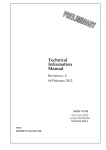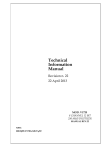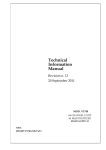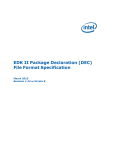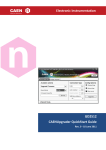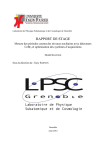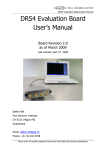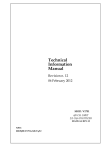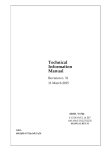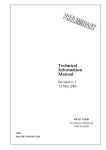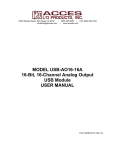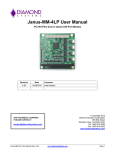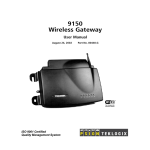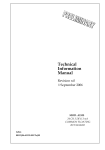Download V1742_REV0 722KB Mar 08 2011 04:39:37 PM
Transcript
Technical Information Manual Revision n. 0 4 February 2011 MOD. V1742 32+2 CH 12 BIT 5 GS/s DIGITIZER MANUAL REV.0 NPO: 00103/09:V1742x.MUTx/00 CAEN will repair or replace any product within the guarantee period if the Guarantor declares that the product is defective due to workmanship or materials and has not been caused by mishandling, negligence on behalf of the User, accident or any abnormal conditions or operations. CAEN declines all responsibility for damages or injuries caused by an improper use of the Modules due to negligence on behalf of the User. It is strongly recommended to read thoroughly the CAEN User's Manual before any kind of operation. CAEN reserves the right to change partially or entirely the contents of this Manual at any time and without giving any notice. Disposal of the Product The product must never be dumped in the Municipal Waste. Please check your local regulations for disposal of electronics products. MADE IN ITALY : We stress the fact that all the boards are made in Italy because in this globalized world, where getting the lowest possible price for products sometimes translates into poor pay and working conditions for the people who make them, at least you know that who made your board was reasonably paid and worked in a safe environment. (this obviously applies only to the boards marked "MADE IN ITALY", we can not attest to the manufacturing process of "third party" boards). Document type: User's Manual (MUT) Title: Mod.V1742 32+2 Ch. 12bit 5GS/s Switched-Capacitor Digitizer Revision date: 04/02/2011 Revision: 0 TABLE OF CONTENTS 1. 2. GENERAL DESCRIPTION.........................................................................................................................8 1.1. OVERVIEW ...............................................................................................................................................8 1.2. BLOCK DIAGRAM .....................................................................................................................................9 TECHNICAL SPECIFICATIONS ............................................................................................................10 2.1. PACKAGING AND COMPLIANCY ..............................................................................................................10 2.2. POWER REQUIREMENTS ..........................................................................................................................10 2.3. FRONT PANEL.........................................................................................................................................11 2.4. EXTERNAL CONNECTORS ........................................................................................................................12 2.4.1. INPUT connectors .........................................................................................................................12 2.4.2. CONTROL connectors...................................................................................................................12 2.4.3. ADC REFERENCE CLOCK connectors .......................................................................................12 2.4.4. Digital I/O connectors ...................................................................................................................13 2.4.5. Optical LINK connector ................................................................................................................13 2.5. OTHER FRONT PANEL COMPONENTS .......................................................................................................14 2.5.1. Displays .........................................................................................................................................14 3. 2.6. INTERNAL COMPONENTS ........................................................................................................................14 2.7. TECHNICAL SPECIFICATIONS TABLE .......................................................................................................16 FUNCTIONAL DESCRIPTION................................................................................................................17 3.1. ANALOG INPUT STAGE ............................................................................................................................17 3.2. DOMINO RING SAMPLING .......................................................................................................................17 3.3. TR0 AND TR1 INPUTS ............................................................................................................................18 3.4. CLOCK DISTRIBUTION ............................................................................................................................19 3.4.1. Multi-board synchronization .........................................................................................................20 3.5. DATA CORRECTION ................................................................................................................................21 3.5.1. Cell offset correction .....................................................................................................................21 3.5.2. Index sampling correction .............................................................................................................22 3.5.3. Time correction .............................................................................................................................22 3.6. EVENT STRUCTURE .................................................................................................................................25 3.6.1. Memory FULL management..........................................................................................................26 3.7. TRIGGER MANAGEMENT .........................................................................................................................27 3.7.1. Trigger distribution .......................................................................................................................28 3.8. FRONT PANEL I/OS .................................................................................................................................28 3.9. TEST PATTERN GENERATOR ....................................................................................................................29 3.10. RESET, CLEAR AND DEFAULT CONFIGURATION .................................................................................29 3.10.1. Global Reset ..................................................................................................................................29 3.10.2. Memory Reset ................................................................................................................................29 3.10.3. Timer Reset....................................................................................................................................30 3.11. VMEBUS INTERFACE .........................................................................................................................30 NPO: 00103/09:V1742x.MUTx/00 Filename: V1742_REV0 Number of pages: 50 Page: 3 Document type: User's Manual (MUT) 3.11.1. Title: Mod.V1742 32+2 Ch. 12bit 5GS/s Switched-Capacitor Digitizer Revision date: 04/02/2011 Revision: 0 Addressing capabilities..................................................................................................................30 3.11.1.1. Base address.......................................................................................................................................... 30 3.11.1.2. CR/CSR address ................................................................................................................................... 30 3.11.1.3. Address relocation ................................................................................................................................ 31 3.12. DATA TRANSFER CAPABILITIES ..........................................................................................................31 3.13. EVENTS READOUT ..............................................................................................................................31 3.13.1. Sequential readout.........................................................................................................................31 3.13.1.1. SINGLE D32 ........................................................................................................................................ 32 3.13.1.2. BLOCK TRANSFER D32/D64, 2eVME ............................................................................................. 32 3.13.1.3. CHAINED BLOCK TRANSFER D32/D64 ......................................................................................... 33 3.13.2. 4. Event Polling .................................................................................................................................33 3.14. OPTICAL LINK ....................................................................................................................................33 3.15. SOFTWARE TOOLS ..............................................................................................................................33 VME INTERFACE .....................................................................................................................................35 4.1. REGISTERS ADDRESS MAP ......................................................................................................................35 4.2. CONFIGURATION ROM (0XF000-0XF084; R).........................................................................................36 4.3. GROUP N CHANNEL THRESHOLD (0X1N80; R/W)....................................................................................37 4.4. GROUP N STATUS (0X1N88; R) ...............................................................................................................37 4.5. DAUGHTER BOARD FW REVISION (0X1N8C; R) ......................................................................................37 4.6. GROUP N BUFFER OCCUPANCY (0X1N94; R) ..........................................................................................38 4.7. GROUP N CHANNEL DC OFFSET (0X1N98; R/W).....................................................................................38 4.8. GROUP N ADC CONFIGURATION (0X1N9C; R/W) ...................................................................................38 4.9. DRS4 TEMPERATURE (0X1NA0; R) ........................................................................................................38 4.10. CHANNEL N DAC SEL (0X1NA4; R/W) .............................................................................................38 4.11. GROUP N CHANNEL TRIGGER MASK (0X1NA8; R/W) .........................................................................39 4.12. MEMORY CALIBRATION TABLES ENABLE (0X1NCC; R/W).................................................................39 4.13. MEMORY CALIBRATION TABLES DATA (0X1ND0; R/W).....................................................................39 4.14. GROUP N TR THRESHOLD (0X1ND4; R/W)..........................................................................................39 4.15. GROUP N TR DC OFFSET (0X1NDC; R/W) ..........................................................................................39 4.16. GROUP CONFIGURATION REGISTER (0X8000; R/W) ............................................................................40 4.17. GROUP CONFIGURATION BIT SET (0X8004; W) ..................................................................................41 4.18. GROUP CONFIGURATION BIT CLEAR (0X8008; W) .............................................................................41 4.19. BUFFER ORGANIZATION (0X800C; R/W) ............................................................................................41 4.20. CUSTOM SIZE (0X8020; R/W) .............................................................................................................41 4.21. INITIAL TEST WAVE VALUE (0X807C) ................................................................................................41 4.22. SAMPLING FREQUENCY (0X80D8) .....................................................................................................41 NPO: 00103/09:V1742x.MUTx/00 Filename: V1742_REV0 Number of pages: 50 Page: 4 Document type: User's Manual (MUT) 5. Title: Mod.V1742 32+2 Ch. 12bit 5GS/s Switched-Capacitor Digitizer Revision date: 04/02/2011 Revision: 0 4.23. ACQUISITION CONTROL (0X8100; R/W)..............................................................................................42 4.24. ACQUISITION STATUS (0X8104; R) .....................................................................................................42 4.25. SOFTWARE TRIGGER (0X8108; W)......................................................................................................43 4.26. TRIGGER SOURCE ENABLE MASK (0X810C; R/W) ..............................................................................43 4.27. FRONT PANEL TRIGGER OUT ENABLE MASK (0X8110; R/W) .............................................................43 4.28. POST TRIGGER SETTING (0X8114; R/W) .............................................................................................43 4.29. FRONT PANEL I/O DATA (0X8118; R/W).............................................................................................44 4.30. FRONT PANEL I/O CONTROL (0X811C; R/W)......................................................................................44 4.31. GROUP ENABLE MASK (0X8120; R/W) ...............................................................................................44 4.32. ROC FPGA FIRMWARE REVISION (0X8124; R)..................................................................................45 4.33. EVENT STORED (0X812C; R) ..............................................................................................................45 4.34. SET MONITOR DAC (0X8138; R/W)....................................................................................................45 4.35. BOARD INFO (0X8140; R) ...................................................................................................................45 4.36. MONITOR MODE (0X8144; R/W).........................................................................................................45 4.37. EVENT SIZE (0X814C; R)....................................................................................................................45 4.38. VME CONTROL (0XEF00; R/W) .........................................................................................................46 4.39. VME STATUS (0XEF04; R).................................................................................................................46 4.40. BOARD ID (0XEF08; R/W)..................................................................................................................46 4.41. MCST BASE ADDRESS AND CONTROL (0XEF0C; R/W)......................................................................47 4.42. RELOCATION ADDRESS (0XEF10; R/W)..............................................................................................47 4.43. INTERRUPT STATUS ID (0XEF14; R/W)...............................................................................................47 4.44. INTERRUPT EVENT NUMBER (0XEF18; R/W) ......................................................................................47 4.45. BLT EVENT NUMBER (0XEF1C; R/W)................................................................................................47 4.46. SCRATCH (0XEF20; R/W) ...................................................................................................................47 4.47. SOFTWARE RESET (0XEF24; W) .........................................................................................................48 4.48. SOFTWARE CLEAR (0XEF28; W) ........................................................................................................48 4.49. FLASH ENABLE (0XEF2C; R/W)..........................................................................................................48 4.50. FLASH DATA (0XEF30; R/W)..............................................................................................................48 4.51. CONFIGURATION RELOAD (0XEF34; W).............................................................................................48 INSTALLATION ........................................................................................................................................49 5.1. POWER ON SEQUENCE ...........................................................................................................................49 5.2. POWER ON STATUS ................................................................................................................................49 5.3. FIRMWARE UPGRADE..............................................................................................................................49 NPO: 00103/09:V1742x.MUTx/00 Filename: V1742_REV0 Number of pages: 50 Page: 5 Document type: User's Manual (MUT) Title: Mod.V1742 32+2 Ch. 12bit 5GS/s Switched-Capacitor Digitizer Revision date: 04/02/2011 Revision: 0 LIST OF FIGURES FIG. 1.1: MOD. V1742 BLOCK DIAGRAM .................................................................................................................9 FIG. 2.1: MOD. V1742 FRONT PANEL ......................................................................................................................11 FIG. 2.2: MCX CONNECTOR ...................................................................................................................................12 FIG. 2.3: AMP CLK IN/OUT CONNECTOR ............................................................................................................12 FIG. 2.4: PROGRAMMABLE IN/OUT CONNECTOR ..................................................................................................13 FIG. 2.5: LC OPTICAL CONNECTOR ........................................................................................................................13 FIG. 2.6: ROTARY AND DIP SWITCHES LOCATION ....................................................................................................15 FIG. 3.1: ANALOG INPUT DIAGRAM ........................................................................................................................17 FIG. 3.2: INPUT DIAGRAM .......................................................................................................................................18 FIG. 3.3: TR0 LOGIC BLOCK DIAGRAM....................................................................................................................19 FIG. 3.4: CLOCK DISTRIBUTION DIAGRAM ..............................................................................................................20 FIG. 3.5: SAMPLED WAVEFORM AND NOISE HISTOGRAM BEFORE CELL OFFSET CORRECTION .................................21 FIG. 3.6: SAMPLED WAVEFORM AND NOISE HISTOGRAM AFTER CELL OFFSET CORRECTION ....................................21 FIG. 3.7: SAMPLED WAVEFORM AND NOISE HISTOGRAM AFTER INDEX SAMPLING CORRECTION .............................22 FIG. 3.8: SAMPLED TR0 SIGNAL IN GR0 AND GR1 BEFORE TIME CORRECTION ......................................................22 FIG. 3.9: SAMPLED TR0 SIGNAL IN GR0 AND GR1 AFTER TIME CORRECTION ........................................................23 FIG. 3.10: INL TIME PROFILE OF DRS CHIPS 0 AND 1 BEFORE TIME CORRECTION ...................................................23 FIG. 3.11: INL TIME PROFILE OF DRS CHIPS 0 AND 1 AFTER TIME CORRECTION .....................................................24 FIG. 3.12: EVENT FORMAT .....................................................................................................................................25 FIG. 3.13: GROUP DATA FORMAT...........................................................................................................................26 FIG. 3.14: BLOCK DIAGRAM OF TRIGGER MANAGEMENT ........................................................................................27 FIG. 3.15: FPGA TEST WAVEFORM .........................................................................................................................29 FIG. 3.16: A24 ADDRESSING ...................................................................................................................................30 FIG. 3.17: A32 ADDRESSING ...................................................................................................................................30 FIG. 3.18: CR/CSR ADDRESSING ............................................................................................................................31 FIG. 3.19: SOFTWARE RELOCATION OF BASE ADDRESS ...........................................................................................31 FIG. 3.20: EXAMPLE OF BLT READOUT ..................................................................................................................32 FIG. 3.21: BLOCK DIAGRAM OF THE SOFTWARE TOOLS ...........................................................................................34 LIST OF TABLES TABLE 1.1: MOD. V1742 VERSIONS .........................................................................................................................9 TABLE 2.1: MODEL V1742 POWER REQUIREMENTS................................................................................................10 TABLE 2.2 : FRONT PANEL LEDS ...........................................................................................................................14 NPO: 00103/09:V1742x.MUTx/00 Filename: V1742_REV0 Number of pages: 50 Page: 6 Document type: User's Manual (MUT) Title: Mod.V1742 32+2 Ch. 12bit 5GS/s Switched-Capacitor Digitizer Revision date: 04/02/2011 Revision: 0 TABLE 2.3 : MOD. V1742 TECHNICAL SPECIFICATIONS ..........................................................................................16 TABLE 3.1 : FRONT PANEL I/OS DEFAULT SETTING ................................................................................................28 TABLE 4.1: ADDRESS MAP FOR THE MODEL V1742...............................................................................................35 TABLE 4.2: ROM ADDRESS MAP FOR THE MODEL V1742.....................................................................................37 NPO: 00103/09:V1742x.MUTx/00 Filename: V1742_REV0 Number of pages: 50 Page: 7 Document type: User's Manual (MUT) Title: Mod.V1742 32+2 Ch. 12bit 5GS/s Switched-Capacitor Digitizer Revision date: 04/02/2011 Revision: 0 1. General description 1.1. Overview The Mod. V1742 is a VME board housing two 16+1Channels 12bit 5GS/s Switched Capacitor Digitizer sections, based on DRS4 (Domino Ring Sampler) chip, with 1 Vpp input dynamic range on single ended MCX coaxial connectors. A VME64X mechanics version, Mod. VX1742 is also available. The DC offset is adjustable via 16bit DAC (± 1V range) on each channel and allows tot sample either bipolar (Vin=± 0.5V) or unipolar (full positive Vin= 0 ÷ +1V or negative Vin= 0 ÷ -1V) analog input swing without losing dynamic resolution. The analog input signals are continuously sampled into the DRS4s in a circular analog memory buffer (1024 cells); default sampling frequency is 5GS/s; 2.5GS/s and 1GS/s frequencies can be also programmed. As a trigger signal arrives, all analog memory buffers are frozen and subsequently digitized with a 12bit resolution into a digital memory buffer. The digital memory (128 events deep for each channel, where 1 event = 1024x12bit) allows to store subsequent events, even if the readout is not yet started. Moreover, since the digital memory buffers work like FIFOs, the readout activity from VME or Optical Link does not affect write operations of subsequent events. A common board trigger can be provided via VME or Optical Link, or by TRG-IN input. Two special fast analog trigger inputs TR0 and TR1 (TTL/NIM levels compatible), can be used as lo-latency external trigger signals. These special inputs can be also sampled into the DRS4s analog memory buffers for applications where high resolution timing and time analysis with a common reference signal (like a trigger or system clock) is required. During analog to digital conversion process, the V1742 cannot handles other triggers, this is called Dead Time. Dead time will be increased if also TR0 and/or TR1 channels are sampled in the acquisition of the analog inputs. The module V1742 features a PLL for clock synthesis with a selectable internal or external reference clock source. Multi-board synchronization can be done by driving a clock on CLOCK-IN input, allowing all DRS4s to run synchronously with this external reference. All analog inputs will be sampled at the same time without time drift, allows high resolution timing and time analysis across multiple V1742. The Modules VME interface is VME64X compliant and the data readout can be performed in Single Data Transfer (D32), 32/64 bit Block Transfer (BLT, MBLT, 2eVME, 2eSST) and 32/64 bit Chained Block Transfer (CBLT). The board houses a daisy chainable Optical Link able to transfer data at 80 MB/s, thus it is possible to connect up to 8 ADC boards (256+16 ADC channels) to a single Optical Link Controller (Mod. A2818). Optical Link and VME access are internally arbitrated. NPO: 00103/09:V1742x.MUTx/00 Filename: V1742_REV0 Number of pages: 50 Page: 8 Document type: User's Manual (MUT) Title: Mod.V1742 32+2 Ch. 12bit 5GS/s Switched-Capacitor Digitizer Revision date: 04/02/2011 Revision: 0 Table 1.1: Mod. V1742 versions 1.2. Model Code V1742 WV1742BXAAAA 128 event / ch SRAM Memory 6U-VME64 Form factor V1742B WV1742XAAAAA 1024 event / ch 6U-VME64 VX1742 WVX1742BXAAA 128 event / ch 6U-VME64X VX1742B WVX1742XAAAA 1024 event / ch 6U-VME64X Block Diagram FRONT PANEL DAC ANALOG IN DRS4 ADC BUFFERS FPGA TRn IN CLK OUT DAC CLOCK MANAGER (AD9510) VCXO 500MHz VME CLK IN MUX OSC ADC LOCAL BUS DRS4 ANALOG IN TRIGGERS & SYNC DAC TRG IN TRG OUT ROC [FPGA] S IN MON DAC DIGITAL I/Os - Readout control - VME interface control - Optical link control - Trigger control - External interface control OPTICAL LINK Fig. 1.1: Mod. V1742 Block Diagram The function of each block will be explained in detail in the subsequent sections. NPO: 00103/09:V1742x.MUTx/00 Filename: V1742_REV0 Number of pages: 50 Page: 9 Document type: User's Manual (MUT) Title: Mod.V1742 32+2 Ch. 12bit 5GS/s Switched-Capacitor Digitizer Revision date: 04/02/2011 Revision: 0 2. Technical specifications 2.1. Packaging and Compliancy The module is housed in a 6U-high, 1U-wide VME unit. The board hosts the VME P1, and P2 connectors and fits into both VME/VME64 standard and V430 backplanes. VX1742 versions fit into VME64X compliant crates. In all cases only well ventilated crates must be used. 2.2. Power requirements The power requirements of the module are as follows: Table 2.1: Model V1742 power requirements NPO: 00103/09:V1742x.MUTx/00 Filename: V1742_REV0 +5 V 5.5 A +12 V 200 mA -12 V 300 mA Number of pages: 50 Page: 10 Document type: User's Manual (MUT) 2.3. Title: Mod.V1742 32+2 Ch. 12bit 5GS/s Switched-Capacitor Digitizer Revision date: 04/02/2011 Revision: 0 Front Panel Mod. V560E Mod. V1742 SCALER 32 CH 12 BIT 5 GS/S DIGITIZER Fig. 2.1: Mod. V1742 front panel NPO: 00103/09:V1742x.MUTx/00 Filename: V1742_REV0 Number of pages: 50 Page: 11 Document type: User's Manual (MUT) 2.4. Title: Mod.V1742 32+2 Ch. 12bit 5GS/s Switched-Capacitor Digitizer Revision date: 04/02/2011 Revision: 0 External connectors 2.4.1. INPUT connectors Fig. 2.2: MCX connector Function: Analog input, single ended, Zin=50 Ohm; TR[1,0] (Fast TRG) input, Zin=50 Ohm Mechanical specifications: MCX connector (CS 85MCX-50-0-16 SUHNER) Suggested plug: MCX-50-2-16 type Suggested cable: RG174 type 2.4.2. CONTROL connectors Function: • TRG OUT: Local trigger output (NIM/TTL, on Rt = 50 Ohm) • TRG IN: External trigger input (NIM/TTL, Zin= 50 Ohm) • SYNC/SAMPLE/START (S_IN): Sample front panel input (NIM/TTL, Zin=50 Ohm) • MON/Σ: DAC output 1Vpp on Rt=50 Ohm Mechanical specifications: 00-type LEMO connectors 2.4.3. ADC REFERENCE CLOCK connectors GND CLKCLK+ Fig. 2.3: AMP CLK IN/OUT Connector CLK_IN Function: CLK IN: External clock/Reference input, AC coupled (diff. LVDS, ECL, PECL, LVPECL, CML), Zdiff= 100 Ohm. Mechanical specifications: AMP 3-102203-4 connector CLK_OUT Function: CLOCK OUT: Clock output, DC coupled (diff. LVDS), Zdiff= 100 Ohm. Mechanical specifications: AMP 3-102203-4 connector NPO: 00103/09:V1742x.MUTx/00 Filename: V1742_REV0 Number of pages: 50 Page: 12 Document type: User's Manual (MUT) 2.4.4. Title: Mod.V1742 32+2 Ch. 12bit 5GS/s Switched-Capacitor Digitizer Revision date: 04/02/2011 Revision: 0 Digital I/O connectors Fig. 2.4: Programmable IN/OUT Connector Function: N.16 programmable differential LVDS I/O signals, Zdiff_in= 110 Ohm. Four Independent signal group 0÷3, 4÷7, 8÷11, 12÷15, In / Out direction control; Lowest couple: 0; highest couple: not connected. See also § 3.8. Mechanical specifications: 3M-7634-5002- 34 pin Header Connector 2.4.5. Optical LINK connector Fig. 2.5: LC Optical Connector Mechanical specifications: LC type connector; to be used with Multimode 62.5/125µm cable with LC connectors on both sides (see also § 3.14); CAEN provides optical fiber cables with a duplex connector on the A2818 side and two simplex connectors on the board side; the simplex connector with the black wrap is for the RX line (lower) and the one with the red wrap is for the TX (higher). Electrical specifications: Optical link for data readout and slow control with transfer rate up to 80MB/s; TX/RX, daisy chainable. NPO: 00103/09:V1742x.MUTx/00 Filename: V1742_REV0 Number of pages: 50 Page: 13 Document type: User's Manual (MUT) 2.5. Title: Mod.V1742 32+2 Ch. 12bit 5GS/s Switched-Capacitor Digitizer Revision date: 04/02/2011 Revision: 0 Other front panel components 2.5.1. Displays The front panel hosts the following LEDs: Table 2.2 : Front panel LEDs Name: Colour: Function: DTACK green VME read/write access to the board CLK_IN green External clock enabled. NIM green Standard selection for CLK I/O, TRG OUT, TRG IN, S IN. TTL green Standard selection for CLK I/O, TRG OUT, TRG IN, S IN. LINK green/yellow Network present; Data transfer activity PLL _LOCK green The PLL is locked to the reference clock PLL _BYPS green The reference clock drives directly ADC clocks; the PLL circuit is switched off and the RUN green RUN bit set (see § 4.24) TRG green Trigger accepted DRDY green Event/data (depending on acquisition mode) are present in the Output Buffer BUSY red All the buffers are full OUT_LVDS green Signal group OUT direction enabled. PLL_LOCK LED is turned off. 2.6. Internal components SW2,4,5,6 “Base Addr. [31:16]”: Type: 4 rotary switches Function: Set the VME base address of the module. SW3 “CLOCK SOURCE”: Type Dip Switch Function:Not Used SW1 “FW”: Type: Dip Switch. Function: it allows to select whether the “Standard” (STD) or the “Back up” (BKP) firmware must be loaded at power on; (default position: STD). NPO: 00103/09:V1742x.MUTx/00 Filename: V1742_REV0 Number of pages: 50 Page: 14 Document type: User's Manual (MUT) Title: Mod.V1742 32+2 Ch. 12bit 5GS/s Switched-Capacitor Digitizer Revision date: 04/02/2011 Revision: 0 Fig. 2.6: Rotary and dip switches location NPO: 00103/09:V1742x.MUTx/00 Filename: V1742_REV0 Number of pages: 50 Page: 15 Document type: User's Manual (MUT) 2.7. Title: Mod.V1742 32+2 Ch. 12bit 5GS/s Switched-Capacitor Digitizer Revision date: 04/02/2011 Revision: 0 Technical specifications table Table 2.3 : Mod. V1742 technical specifications Package 1-unit wide VME module Analog Input 32 channels (MCX 50 Ohm); Single-ended; Input range: 1 Vpp Bandwidth: >500MHz; Programmable DAC for Offset Adjust x ch. adjustment range: ±1V Sampling frequency Programmable: 5, 2.5 or 1GS/s TR0, TR1 Input MCX 50 Ohm, NIM/TTL; fast local trigger (TR0 for ch0..15, TR1 for ch16..31) and high resolution timing reference Switched Capacitor array Based on DRS4 chip Switched capacitor ADC 1024 storage cells per channels simultaneously sampled at 5 - 2,5 - 1GS/s (selectable) on all channels After trigger analog samples are digitized by external ADC. Digital Resolution 12 bit Dead Time 110µs Analog inputs only; 181µs Analog inputs + TR0, TR1 inputs ADC Sampling Clock generation sampling clock generation supports two operating modes: PLL mode - internal reference (50 MHz local oscillator) PLL mode - external reference on CLK_IN (Jitter<100ppm, Freq. 50 MHz). Digital I/O CLK_IN (AMP Modu II): AC coupled differential input clock LVDS, ECL, PECL, LVPECL, CML (single ended NIM/TTL available on request) Jitter<100ppm TRG_IN (LEMO 50 Ohm, NIM/TTL) S_IN (LEMO 50 Ohm, NIM/TTL) ADC & Memory control FPGA 1 Altera Cyclone EP3C16 for 16+1 channels Memory Buffer 128 event/ch, (1024 samples per event); Multi Event Buffer with independent read and write access. Trigger Common Trigger TRG_IN (External signal) Software (from VME or Optical Link) Fast local trigger Fast local trigger TR0 and TR1 with individual programmable analog threshold Optical Link CAEN proprietary protocol, up to 80 MB/s transfer rate, Daisy chainable: it is possible to connect up to 8/32 ADC modules to a single Optical Link Controller (Mod. A2818/A3818) Multi Modules Synchronization Allows data alignment and consistency across multiple V1742 modules: CLK_IN allows the synchronization to a common clock source S_IN ensures start acquisition times alignment Upgrade Firmware can be upgraded via VME/Optical Link VME interface VME64X compliant D32, BLT32, MBLT64, CBLT32/64, 2eVME, 2eSST, Multi Cast CyclesTransfer rate: 60MB/s (MBLT64), 100MB/s (2eVME), 160MB/s (2eSST). Sequential and random access to the data of the Multi Event Buffer. The Chained readout allows to read one event from all the boards in a VME crate with a BLT access. Software Libraries (C and LabView), Demos and Software tools for Windows and Linux NPO: 00103/09:V1742x.MUTx/00 Filename: V1742_REV0 Number of pages: 50 Page: 16 Document type: User's Manual (MUT) Title: Mod.V1742 32+2 Ch. 12bit 5GS/s Switched-Capacitor Digitizer Revision date: 04/02/2011 Revision: 0 3. Functional description 3.1. Analog input stage Input dynamic is 1Vpp on single ended MCX coaxial connectors (Zin= 50 Ohm). A 16bit DAC allows to add up to ±1V DC offset in order to preserve the full dynamic range also with uni-polar positive or negative input signal. The input bandwidth ranges from DC to 500 MHz. Input Dynamic Range: 1 Vpp Positive Unipolar +1.50 + 50ohm Input MCX OpAmp - DRS4 ADC FPGA Vref DAC DAC = FSR 12 bit 16 bit +0.50 0 -0.50 Negative Unipolar -1.50 DAC = 0 Bipolar DAC = FSR/2 Fig. 3.1: Analog input diagram 3.2. Domino Ring Sampling The analog input signals are continuously sampled into the DRS4s (Domino Ring Sampler), which consists of an on-chip inverter chain (domino wave circuit) generating a maximum 5GS/s sampling frequency; 2.5GS/s and 1GS/s frequencies can be also programmed (see § 4.21). No external sampling clock is required. This signal opens write switches in all 9 sampling channels, where the differential input signals are sampled (1024 sampling capacitance cells per channel). After being started, the domino wave runs continuously in a circular fashion (after the end of the ring, samples are over written) until decoupled from the write switches by a trigger signal, which freezes the currently stored signal in the sampling capacitance cells. Subsequently the cells are multiplexed into the 12 bit ADCs whose output are stored by the FPGA into the Digital Memory Buffer and ready for readout in the shape of events data. A 16bit DAC allow to add up to ±1V DC offset in order to preserve the full dynamic range also with uni-polar positive or negative input signals NPO: 00103/09:V1742x.MUTx/00 Filename: V1742_REV0 Number of pages: 50 Page: 17 Document type: User's Manual (MUT) Title: Mod.V1742 32+2 Ch. 12bit 5GS/s Switched-Capacitor Digitizer 8 DAC Revision date: 04/02/2011 Revision: 0 16bit DRS4 DWRITE FPGA Analog Input TRn Input DIGITAL MEMORY BUFFER MUX 8 ADC DAC 12bit 16bit Fig. 3.2: Input diagram Detailed documentation of the DRS4 is available at http://drs.web.psi.ch/ 3.3. TR0 and TR1 Inputs The module features two fast trigger inputs TR0 and TR1 with extended level amplitude (TTL/NIM compatible); TR0 is common to group 0 (ch[7..0]) and 1 (ch[15..8]), TR1 to group 2 (ch[23..16]) and 3 (ch[31..24]). TRn signals can be used as external triggers (see § 3.7). Moreover they can be also sampled into the DRS4s analog memory buffers for applications where high resolution timing and time analysis with a common reference signal (like a trigger or system clock) is required; this is achieved through the Configuration Register, “Signal TRn Readout Enable” bit setting (see § 4.12) allows to store TR0 input with samples coming from group 0 and 1 and TR1 with those from group 2 and 3. To properly handle bipolar signals and also unipolar positive or negative signal, a 16 bit DAC allow you to add a DC offset to TRn; offset value can be programmed via Group n DC Offset register (see § 4.7) When the TRn signals are used as trigger, they are processed by an internal comparator, whose threshold can be programmed via Group n TRn Threshold register (see § 0): as the threshold is exceeded, the FPGA triggers the DRS4’s and samples digitizing takes place. The trigger signals can be sensed either on the leading or the trailing edge, depending on Configuration register setting (see § 4.12). NPO: 00103/09:V1742x.MUTx/00 Filename: V1742_REV0 Number of pages: 50 Page: 18 Document type: User's Manual (MUT) Title: Mod.V1742 32+2 Ch. 12bit 5GS/s Switched-Capacitor Digitizer 16bit DAC Dc offset Revision date: 04/02/2011 GROUP 1 GROUP 0 FPGA DRS4 TR0 Input ADC Revision: 0 DIGITAL MEMORY BUFFER 12bit COMP DAC threshold 16bit Fig. 3.3: TR0 logic block diagram 3.4. Clock Distribution The module V1742 features a PLL for clock synthesis with a selectable internal or external reference clock source. Multi-board synchronization can be done by driving a clock on CLOCK-IN input, allowing all DRS4s to run synchronously with this external reference. All analog inputs will be sampled at the same time without time drift, allows high resolution timing and time analysis across multiple V1742. The module clock is provided by OSC-CLK and REF-CLK. OSC-CLK is a fixed 50MHz clock provided by an on board oscillator; it handles both VME and Local Bus (communication between motherboard and mezzanine boards; see red traces in the figure below). REF-CLK handles trigger logic, acquisition logic (samples storage into RAM, buffer freezing on trigger) through a clock chain. Such domain can use either an external (via front panel signal) or an internal (via local oscillator) source (selection is performed via dip switch SW1, see § 2.6); in the latter case OSC-CLK and REF-CLK will be synchronous (the operation mode remains the same anyway). REF-CLK is processed by AD9510 device, which delivers 6 clock out signals; 4 signals are sent to ADCs, one to the trigger logic and one to drive CLK-OUT output (refer to AD9510 data sheet for more details, available on http://www.analog.com/ NPO: 00103/09:V1742x.MUTx/00 Filename: V1742_REV0 Number of pages: 50 Page: 19 Document type: User's Manual (MUT) Title: Mod.V1742 32+2 Ch. 12bit 5GS/s Switched-Capacitor Digitizer Revision date: 04/02/2011 Revision: 0 Fig. 3.4: Clock distribution diagram 3.4.1. Multi-board synchronization To be implemented NPO: 00103/09:V1742x.MUTx/00 Filename: V1742_REV0 Number of pages: 50 Page: 20 Document type: User's Manual (MUT) 3.5. Title: Mod.V1742 32+2 Ch. 12bit 5GS/s Switched-Capacitor Digitizer Revision date: 04/02/2011 Revision: 0 Data correction Three types of data correction are required, in order to compensate for unavoidable construction differences in the DRS4 chips. All boards are factory calibrated during production test and correction parameters are saved on board (see § 5.3). Application software provided by CAEN recovers automatically the calibration parameters and runs them in order to correct the stored data events. 3.5.1. Cell offset correction Unavoidable construction differences between the “analog memory cells” (see § 3.1) require an amplitude calibration algorithm. The following images show the sampled waveform and noise histogram before and after correction: Fig. 3.5: Sampled waveform and noise histogram before cell offset correction Fig. 3.6: Sampled waveform and noise histogram after cell offset correction NPO: 00103/09:V1742x.MUTx/00 Filename: V1742_REV0 Number of pages: 50 Page: 21 Document type: User's Manual (MUT) 3.5.2. Title: Mod.V1742 32+2 Ch. 12bit 5GS/s Switched-Capacitor Digitizer Revision date: 04/02/2011 Revision: 0 Index sampling correction It has been observed a fixed pattern noise, introduced by the DRS4, over the last samples (~30 samples) in a waveform, therefore the “index sampling correction” is necessary; this correction actually reduces this noise, thus, anytime the best accuracy is required, the last ~30 samples should be rejected. Fig. 3.7: Sampled waveform and noise histogram after index sampling correction 3.5.3. Time correction The sampling sequence is handled by the DRS4 through 1024 physical delay lines; the unavoidable construction differences between such delay lines must be compensated through a time calibration. The following figures show the fast trigger signal (TR0) sampled by the DRS chip related to Group 0 and 1 and the integral non linearity (INL) time profile of DRS chips, before and after correction: Fig. 3.8: Sampled TR0 signal in GR0 and GR1 before time correction NPO: 00103/09:V1742x.MUTx/00 Filename: V1742_REV0 Number of pages: 50 Page: 22 Document type: User's Manual (MUT) Title: Mod.V1742 32+2 Ch. 12bit 5GS/s Switched-Capacitor Digitizer Revision date: 04/02/2011 Revision: 0 Fig. 3.9: Sampled TR0 signal in GR0 and GR1 after time correction Fig. 3.10: INL time profile of DRS chips 0 and 1 before time correction NPO: 00103/09:V1742x.MUTx/00 Filename: V1742_REV0 Number of pages: 50 Page: 23 Document type: User's Manual (MUT) Title: Mod.V1742 32+2 Ch. 12bit 5GS/s Switched-Capacitor Digitizer Revision date: 04/02/2011 Revision: 0 Fig. 3.11: INL time profile of DRS chips 0 and 1 after time correction NPO: 00103/09:V1742x.MUTx/00 Filename: V1742_REV0 Number of pages: 50 Page: 24 Document type: User's Manual (MUT) 3.6. Title: Mod.V1742 32+2 Ch. 12bit 5GS/s Switched-Capacitor Digitizer Revision date: 04/02/2011 Revision: 0 Event structure An event is structured as follows: − Header (four 32-bit words) − Data (variable size and format) The event can be readout either via VME or Optical Link; data format is 32 bit word. 31 30 29 28 27 26 25 24 23 22 21 20 19 18 17 16 15 14 13 12 11 10 9 HEADER 1 0 1 0 8 7 6 5 4 3 2 1 TOTAL EVENT SIZE (LWORDS) BOARD ID PATTERN GR.MASK EVENT COUNTER EVENT TIME TAG GROUP 0 GROUP 0 EVENT DESCRIPTION WORD GROUP 0 CHANNEL DATA GROUP 0 TRIGGER TIME TAG GROUP 1 GROUP 1 EVENT DESCRIPTION WORD GROUP 1 CHANNEL DATA GROUP 1 TRIGGER TIME TAG GROUP 1 GROUP 0 EVENT DESCRIPTION WORD GROUP 0 CHANNEL DATA GROUP 1 TRIGGER TIME TAG GROUP 1 GROUP 1 EVENT DESCRIPTION WORD GROUP 1 CHANNEL DATA GROUP 1 TRIGGER TIME TAG Fig. 3.12: Event Format The Header is composed by four words, namely: - Size of the event (number of 32 bit words) - Board ID (GEO); 16 bit pattern, latched on the LVDS I/O as one trigger arrives; Group Mask (=1: Groups participating to event; ex GR2 and GR3 participating → Gr_Mask: 0xC, this information must be used by the software to acknowledge what Group the samples are coming from; the first event contains the samples from the Group with the lowest number) - Event Counter: It is the trigger counter; it can count either accepted triggers only, or all triggers (see § 4.20). - Trigger Time Tag: It is a 32 bit counter (31 bit count + 1 overflow bit), which is reset either as acquisition starts or via front panel Reset signal (see § 0), and is incremented at each sampling clock hit. It is the trigger time reference. Each group is composed by 8 analog channels (group 0 = channel 0 – 7, group 1 = channel 8 – 15 etc.) and by the special channel TRn: such signal is common to two groups; it can be used as Local Trigger or “digitized” and stored with the data for high resolution timing analysis between the ADC channels and the TRn itself. NPO: 00103/09:V1742x.MUTx/00 Filename: V1742_REV0 Number of pages: 50 Page: 25 0 Document type: User's Manual (MUT) Title: Mod.V1742 32+2 Ch. 12bit 5GS/s Switched-Capacitor Digitizer Revision date: 04/02/2011 Revision: 0 TR0 can trigger Group 0 and Group 1 and can be stored with data from Group 0 (therefore the stored waveform will be labelled as Tr00) and with data from Group 1 (therefore the stored waveform will be labelled as Tr01); TR1 can trigger Group 2 and Group 3 and can be stored with data from Group 2 (therefore the stored waveform will be labelled as Tr12) and with data from Group 3 (therefore the stored waveform will be labelled as Tr13). The part of an event related to each group has the following format (example of Group 0): 31 30 29 28 27 26 25 24 23 22 21 20 19 18 17 16 15 14 13 12 11 10 0 0 START INDEX CELL 0 S0-CH2 (LO) 0 FREQ 0 0 9 8 0 TR S0-CH3 S0-CH7 S0-CH6 4 3 2 1 S0-CH2(HI) S0-CH5(HI) S1-CH1 S1-CH5(LO) 5 S0-CH0 S0-CH4 S1-CH2 (LO) 6 SIZE CH 0..7 S0-CH1 S0-CH5(LO) 7 S1-CH0 S1-CH4 S1-CH3 S1-CH7 S1-CH2(HI) S1-CH6 S1-CH5(HI) S(N-1)-CH6 S(N-1)-CH5(HI) …. S(N-1)-CH7 S2-TR00 (LO) S1-TR00 S5-TR00(LO) S0-TR00 S4-TR00 S3-TR00 S7-TR00 S2-TR00(HI) S6-TR00 S5-TR00(HI) S(N-2)- TR00 S(N-3)- TR00(HI) …. S(N-1)- TR00 31 30 TRIGGER TIME TAG Fig. 3.13: Group Data Format In the Group Event Description Word (yellow in the figure above) the following fields are shown: - Bit [29:20] Start Index Cell of DRS4 related to this event - Bit [17:16] (sampling frequency): 00 = 5GS/s 01 = 2.5GS/s 10 = 1GS/s 11 = not used - Bit [12] (tr): 0 = TRn signal not present in readout 1 = TRn signal present in readout - Bit [11:0] Size related to channel 0-7 (number of 32 bit words): when each channel has 1024 samples, “Size Ch 0-7” is 0xC00. If readout of TRn is disabled, data related to such channel (light blue in figure above) are not present in the event; if readout of TRn is enabled, data size related to such channel is Size (TRn) = (Size Ch 0-7)/8. Trigger Time Tag records the Trigger arrival time; each bin has a 8.5ns width. 3.6.1. Memory FULL management Bit5 of Acquisition Control register (see § 4.23), allows to select Memory FULL management mode: NPO: 00103/09:V1742x.MUTx/00 Filename: V1742_REV0 Number of pages: 50 Page: 26 0 Document type: User's Manual (MUT) Title: Mod.V1742 32+2 Ch. 12bit 5GS/s Switched-Capacitor Digitizer Revision date: 04/02/2011 Revision: 0 In Normal Mode the board becomes full, whenever all buffers are full; otherwise (“Always one buffer free” mode) it is possible to always keep one buffer free: board becomes full, whenever N-1buffers are full; with N = nr. of blocks. In Normal Mode, the board waits until one buffer is filled since FULL status is exited (whether the trigger is overlapped or not). The board exits FULL status at the moment which the last datum from the last channel participating to the event is read. In “Always one buffer free” mode, one buffer cannot be used (therefore it is NOT POSSIBLE, with this mode, to set Buffer Code to 0000; see § 4.19), but this allows to eliminate dead time when FULL status is exited. 3.7. Trigger management Signal digitization can be triggered basically in two ways: • Common trigger: a trigger produced via software (via VME or Optical Link) or sent via front panel TRG_IN signal (NIM/TTL signal on LEMO connector, 50 Ohm impedance.). In this case, all the channels in a board share the same trigger. • Low latency trigger: a logic level fed directly into the DRS4 via the front panel TRn signals. In this case, one TRn signal triggers two groups (TR0 for Groups 0 and 1; TR1 for Groups 2 and 3) As a trigger signal arrives, the ADC analog buffers related to that trigger, are frozen and then digitized with a 12bit resolution into the digital memory buffer. During analog to digital conversion process, the V1742 cannot handles other triggers; this “Dead Time” is larger if also TR0 and/or TR1 input channels are sampled together with the analog inputs (see §3.3). The TR0 and TR1 are actually analog inputs, but they are also TTL/NIM compatible; in order to use them as low latency external trigger signals, it is necessary to set properly the Configuration Register “Local TRn Trigger Enable” bit (see §3.3). Once the acquisition is triggered in one of the ways described above, digitization takes place as described in § 3.2. Mezzanines Mother Board Memory Buffers TRG OUT TRG IN D Q TRIGGER Acquisition Logic ADC Digital Thresholds DRS4 DRS4 8 x8 SCLK 8 LOCAL TRG Enable Mask 8 TR0 TR1 SW TRG VME Interface Local Bus Interface Fig. 3.14: Block diagram of Trigger management NPO: 00103/09:V1742x.MUTx/00 Filename: V1742_REV0 Number of pages: 50 Page: 27 Document type: User's Manual (MUT) Title: Mod.V1742 32+2 Ch. 12bit 5GS/s Switched-Capacitor Digitizer 3.7.1. Revision date: 04/02/2011 Revision: 0 Trigger distribution The OR of all the enabled trigger sources, after being synchronized with the internal clock, becomes the global trigger of the board and is fed in parallel to all the channels, which store an event. A Trigger Out is also generated on the relevant front panel TRG_OUT connector (NIM or TTL), and allows to extend the trigger signal to other boards. For example, in order to start the acquisition on all the channels in the crate, as one of the channels ramps over threshold, the Local Trigger must be enabled as Trigger Out, the Trigger Out must then be fed to a Fan Out unit; the obtained signal has to be fed to the External Trigger Input of all the boards in the crate (including the board which generated the Trigger Out signal). 3.8. Front Panel I/Os The V1742 is provided with 16 programmable general purpose LVDS I/O signals. Signals can be programmed via VME (see § 4.29 and § 4.30). Default configuration is: Table 3.1 : Front Panel I/Os default setting Nr. Direction Description 0 out Group 0 Trigger Request 1 out Group 1 Trigger Request 2 out Group 2 Trigger Request 3 out Group 3 Trigger Request 4 - - 5 - - 6 - - 7 - - 8 out Memory Full 9 out Event Data Ready 10 out Channels Trigger 11 out RUN Status 12 in Trigger Time Tag Reset (active low) 13 in Memory Clear (active low) 14 - RESERVED 15 - RESERVED NPO: 00103/09:V1742x.MUTx/00 Filename: V1742_REV0 Number of pages: 50 Page: 28 Document type: User's Manual (MUT) Title: Mod.V1742 32+2 Ch. 12bit 5GS/s Switched-Capacitor Digitizer Revision date: 04/02/2011 Revision: 0 3.9. Test pattern generator The FPGA can emulate the ADC and write into memory a sawtooth signal for test purposes. It can be enabled via Group Configuration register, see § 4.16. The following figure shows the test waveforms for even and odd groups respectively. Even channel test wave 4800 4095 4000 3200 2400 1600 800 0 0 800 1600 2400 3200 4000 4800 Odd channel test wave 4800 4095 4000 3200 2400 1600 800 0 0 800 1600 2400 3200 4000 4800 Fig. 3.15: FPGA test waveform Since an event is made up of up to 1024 samples, the test event samples only a “portion” of the sawtooth; the start point of the sampling can be programmed via Initial Test Wave Value register (see § 4.21); for example if this register is set to 0x0FF then the channels in the even groups sample the ramp between 255 and 1278; the channels in the odd groups instead sample the complementary value, therefore between 3840 and 2817. 3.10. Reset, Clear and Default Configuration 3.10.1. Global Reset Global Reset is performed at Power ON of the module or via a VME RESET (SYS_RES), see § 4.47. It allows to clear the data off the Output Buffer, the event counter and performs a FPGAs global reset, which restores the FPGAs to the default configuration. It initializes all counters to their initial state and clears all detected error conditions. 3.10.2. Memory Reset The Memory Reset clears the data off the Output Buffer. The Memory Reset can be forwarded via either a write access to Software Clear Register (see § 4.48) or with a pulse sent to the front panel Memory Clear input (see § 3.8). NPO: 00103/09:V1742x.MUTx/00 Filename: V1742_REV0 Number of pages: 50 Page: 29 Document type: User's Manual (MUT) 3.10.3. Title: Mod.V1742 32+2 Ch. 12bit 5GS/s Switched-Capacitor Digitizer Revision date: 04/02/2011 Revision: 0 Timer Reset The Timer Reset allows to initialize the timer which allows to tag an event. The Timer Reset can be forwarded with a pulse sent to Trigger Time Tag Reset input (see § 3.8). 3.11. VMEBus interface The module is provided with a fully compliant VME64/VME64X interface (see § 1.1), whose main features are: − EUROCARD 9U Format − J1/P1 and J2/P2 with either 160 pins (5 rows) or 96 (3 rows) connectors − A24, A32 and CR-CSR address modes − D32, BLT/MBLT, 2eVME, 2eSST data modes − MCST write capability − CBLT data transfers − RORA interrupter − Configuration ROM 3.11.1. Addressing capabilities 3.11.1.1. Base address The module works in A24/A32 mode. The Base Address of the module can be fixed through four rotary switches (see § 2.6) and is written into a word of 24 or 32 bit. The Base Address can be selected in the range: 0x000000ÅÆ0xFF0000 31 A24 mode 16 15 24 23 0 OFFSET 45 23 0 F E 1 2 789 BC D BC D F 0 6 A A 3 45 SW5 78 9 E SW4 6 1 Fig. 3.16: A24 addressing 0x00000000ÅÆ0xFFFF0000 A32 mode 24 23 31 16 15 0 OFFSET 3 45 2 3 45 2 E F 0 1 1 E 45 78 9 BC D 23 6 A F 1 E 3 45 SW5 78 9 BC D 0 6 A BC D BC D 2 SW4 78 9 A A F 0 6 0 F SW3 78 9 E SW2 6 1 Fig. 3.17: A32 addressing The Base Address of the module is selected through four rotary switches (see § 2.6), then it is validated only with either a Power ON cycle or a System Reset (see § 0). 3.11.1.2. CR/CSR address GEO address is picked up from relevant backplane lines and written onto bit 23..19 of CR/CSR space, indicating the slot number in the crate; the recognized Address Modifier for this cycle is 2F. This feature is implemented only on versions with 160pin connectors. NPO: 00103/09:V1742x.MUTx/00 Filename: V1742_REV0 Number of pages: 50 Page: 30 Document type: User's Manual (MUT) Title: Mod.V1742 32+2 Ch. 12bit 5GS/s Switched-Capacitor Digitizer Revision date: 04/02/2011 24 23 19 18 16 15 31 GEO Revision: 0 0 OFFSET Fig. 3.18: CR/CSR addressing 3.11.1.3. Address relocation Relocation Address register (see § 4.42) allows to set via software the board Base Address (valid values ≠ 0). Such register allows to overwrite the rotary switches settings; its setting is enabled via VME Control Register (see § 4.34). The used addresses are: A32 31 24 23 16 15 0 OFFSET ADER H 24 23 software relocation 16 15 0 OFFSET A24 31 ADER L ADER L software relocation Fig. 3.19: Software relocation of base address 3.12. Data transfer capabilities The board supports D32 single data readout, Block Transfer BLT32 and MBLT64, 2eVME and 2eSST cycles. Sustained readout rate is up to 60 MB/s with MBLT64, up to 100 MB/s with 2eVME and up to 160 MB/s with 2eSST. 3.13. Events readout 3.13.1. Sequential readout The events, once written in the SRAMs (Memory Event Buffers), become available for readout via VME. During the memory readout, the board can continue to store more events (independently from the readout) on the free buffers. The acquisition process is therefore “deadtimeless”, until the memory becomes full. Although the memories are SRAMs, VMEBus does not handle directly the addresses, but takes them from a FIFO. Therefore, data are read from the memories sequentially, according to the selected Readout Logic, from a memory space mapped on 4Kbytes (0x0000÷0x0FFC). The events are readout sequentially and completely, starting from the Header of the first available event, followed by the Trigger Time Tag, the Event Counter and all the samples of the channels (from 0 to 7). Once an event is completed, the relevant memory buffer becomes free and ready to be written again (old data are lost). After the last word in an event, the first word (Header) of the subsequent event is readout. It is not possible to readout an event partially. NPO: 00103/09:V1742x.MUTx/00 Filename: V1742_REV0 Number of pages: 50 Page: 31 Document type: User's Manual (MUT) Title: Mod.V1742 32+2 Ch. 12bit 5GS/s Switched-Capacitor Digitizer 3.13.1.1. Revision date: 04/02/2011 Revision: 0 SINGLE D32 This mode allows to readout a word per time, from the header (actually 4 words) of the first available event, followed by all the words until the end of the event, then the second event is transferred. The exact sequence of the transferred words is shown in § 3.5. We suggest, after the 1st word is transferred, to check the Event Size information and then do as many D32 cycles as necessary (actually Event Size -1) in order to read completely the event. 3.13.1.2. BLOCK TRANSFER D32/D64, 2eVME BLT32 allows, via a single channel access, to read N events in sequence, N is set via the BLT Event Number register (see § 4.45). [Event Size] = [4*(Group Size)] + [16 bytes] Group Size depends on Custom Size setting (see § 4.20) and whether TRn signals are stored in the event or not. Then it is necessary to perform as many cycles as required in order to readout the programmed number of events. We suggest to enable BERR signal during BLT32 cycles, in order to end the cycle avoiding filler readout. The last BLT32 cycle will not be completed, it will be ended by BERR after the #N event in memory is transferred (see example in the figure below). Fig. 3.20: Example of BLT readout Since some 64 bit CPU’s cut off the last 32 bit word of a transferred block, if the number of words composing such block is odd, it is necessary to add a dummy word (which has then to be removed via software) in order to avoid data loss. This can be achieved by setting the ALIGN64 bit in the VME Control register (see § 4.34). MBLT64 cycle is similar to the BLT32 cycle, except that the address and data lines are multiplexed to form 64 bit address and data buses. The 2eVME allows to achieve higher transfer rates thanks to the requirement of only two edges of the two control signals (DS and DTACK) to complete a data cycle. NPO: 00103/09:V1742x.MUTx/00 Filename: V1742_REV0 Number of pages: 50 Page: 32 Document type: User's Manual (MUT) Title: Mod.V1742 32+2 Ch. 12bit 5GS/s Switched-Capacitor Digitizer 3.13.1.3. Revision date: 04/02/2011 Revision: 0 CHAINED BLOCK TRANSFER D32/D64 The V1742 allows to readout events from more daisy chained boards (Chained Block Transfer mode). The technique which handles the CBLT is based on the passing of a token between the boards; it is necessary to verify that the used VME crate supports such cycles. Several contiguous boards, in order to be daisy chained, must be configured as “first”, “intermediate” or “last” via MCST Base Address and Control Register (see § 4.41). A common Base Address is then defined via the same register; when a BLT cycle is executed at the address CBLT_Base + 0x0000 ÷ 0x0FFC, the “first” board starts to transfer its data, driving DTACK properly; once the transfer is completed, the token is passed to the second board via the IACKIN-IACKOUT lines of the crate, and so on until the “last” board, which completes the data transfer and asserts BERR (which has to be enabled): the Master then ends the cycle and the slave boards are rearmed for a new acquisition. If the size of the BLT cycle is smaller than the events size, the board which has the token waits for another BLT cycle to begin (from the point where the previous cycle has ended). 3.13.2. Event Polling A read access to Event Size register (see § 4.36) allows “polling” the number of 32 bit words composing the next event to be read: this permits to perform a properly sized (according to the Event Size information) BLT readout from the Memory Event Buffer. 3.14. Optical Link The board houses a daisy chainable Optical Link (communication path which uses optical fiber cables as physical transmission line) able to transfer data at 80 MB/s, therefore it is possible to connect up to eight V1742 to a single Optical Link Controller: for more information, see www.caen.it (path: Products / Front End / PCI/PCIe / Optical Controller) The parameters for read/write accesses via optical link are the same used by VME cycles (Address Modifier, Base Address, data Width, etc); wrong parameter settings cause Bus Error. VME Control Register bit 3 (see § 0) allows to enable the module to broadcast an interrupt request on the Optical Link; the enabled Optical Link Controllers propagate the interrupt on the PCI bus as a request from the Optical Link is sensed. VME and Optical Link accesses take place on independent paths and are handled by board internal controller, with VME having higher priority; anyway it is better to avoid accessing the board via VME and Optical Link simultaneously. 3.15. Software tools CAEN provides a library designed to control all kind of digitizer models: the CAENDigitizer, available for both Linux and Windows platform (32 and 64Bits). The library is oriented to C/C++ programmers and for Labview developers. The CAENDigitizer is in its turn implemented on a lower-level library, the CAENComm as described in the picture below: NPO: 00103/09:V1742x.MUTx/00 Filename: V1742_REV0 Number of pages: 50 Page: 33 Document type: User's Manual (MUT) Title: Mod.V1742 32+2 Ch. 12bit 5GS/s Switched-Capacitor Digitizer Revision date: 04/02/2011 Revision: 0 Fig. 3.21: Block diagram of the software tools Demo software applications that use CAENDigitizer library and tools to upgrade the digitizers firmware (based on the CAENComm library) are also available; all demos and high-level programs are provided with their source code and can be used as a starting point for the development of User-specific applications. For more information about the CAENDigitizer, the CAENComm and all the high-level software for this digitizer, please see www.caen.it website (Software download section). NPO: 00103/09:V1742x.MUTx/00 Filename: V1742_REV0 Number of pages: 50 Page: 34 Document type: User's Manual (MUT) Title: Mod.V1742 32+2 Ch. 12bit 5GS/s Switched-Capacitor Digitizer Revision date: 04/02/2011 Revision: 0 4. VME Interface The following sections will describe in detail the board’s VME-accessible registers content. Registers whose name begins with “Group n”, are referred to channel groups, with index “n” in the address going from 0 to 3; each group is composed by eight subsequent channels. N.B.: bit fields that are not described in the register bit map are reserved and must not be over written by the User. 4.1. Registers address map Table 4.1: Address Map for the Model V1742 REGISTER NAME ADDRESS EVENT READOUT BUFFER 0x0000-0x0FFC A24/A32/A64 D32 ASIZE DSIZE MODE H_RES S_RES CLR R X X Group n Channel THRESHOLD 0x1n80 A24/A32 D32 R/W X X Group n STATUS 0x1n88 A24/A32 D32 R X X Daughter board FW revision 0x1n8C A24/A32 D32 R Group n BUFFER OCCUPANCY 0x1n94 A24/A32 D32 R X X Group n Channel DC offset 0x1n98 A24/A32 D32 R/W X X Group n DAC SEL 0x1nA4 A24/A32 D32 R/W X X DRS4 n Temperature 0x1nA0 A24/A32 D32 R X X Group n CHANNEL TRIGGER ENABLE MASK 0x1nA8 A24/A32 D32 R/W X X Memory Calibration Tables ENABLE 0x1nCC A24/A32 D32 R/W X X Memory Calibration Tables DATA 0x1nD0 A24/A32 D32 R/W X X Group n TR THRESHOLD 0x1nD4 A24/A32 D32 R/W X X Group n TR DC offset 0x1nDC A24/A32 D32 R/W X X Group CONFIGURATION 0x8000 A24/A32 D32 R/W X X Group CONFIGURATION BIT SET 0x8004 A24/A32 D32 W X X Group CONFIGURATION BIT CLEAR 0x8008 A24/A32 D32 W X X BUFFER ORGANIZATION 0x800C A24/A32 D32 R/W X X CUSTOM SIZE 0x8020 A24/A32 D32 R/W X X INITIAL TEST WAVE 0x807C A24/A32 D32 R/W X X SAMPLING FREQUENCY 0x80D8 A24/A32 D32 R/W X X ACQUISITION CONTROL 0x8100 A24/A32 D32 R/W X X ACQUISITION STATUS 0x8104 A24/A32 D32 R X X SW TRIGGER 0x8108 A24/A32 D32 W TRIGGER SOURCE ENABLE MASK 0x810C A24/A32 D32 R/W X X FRONT PANEL TRIGGER OUT ENABLE MASK 0x8110 A24/A32 D32 R/W X X POST TRIGGER SETTING 0x8114 A24/A32 D32 R/W X X FRONT PANEL I/O DATA 0x8118 A24/A32 D32 R/W X X FRONT PANEL I/O CONTROL 0x811C A24/A32 D32 R/W X X Group ENABLE MASK 0x8120 A24/A32 D32 R/W X X ROC FPGA FIRMWARE REVISION 0x8124 A24/A32 D32 R NPO: 00103/09:V1742x.MUTx/00 Filename: V1742_REV0 Number of pages: 50 X X Page: 35 Document type: User's Manual (MUT) Title: Mod.V1742 32+2 Ch. 12bit 5GS/s Switched-Capacitor Digitizer Revision date: 04/02/2011 Revision: 0 REGISTER NAME ADDRESS ASIZE DSIZE MODE H_RES S_RES CLR EVENT STORED 0x812C A24/A32 D32 R X X X X SET MONITOR DAC 0x8138 A24/A32 D32 R/W BOARD INFO 0x8140 A24/A32 D32 R MONITOR MODE 0x8144 A24/A32 D32 R/W X X EVENT SIZE 0x814C A24/A32 D32 R X X X VME CONTROL 0xEF00 A24/A32 D32 R/W VME STATUS 0xEF04 A24/A32 D32 R BOARD ID 0xEF08 A24/A32 D32 R/W X MULTICAST BASE ADDRESS & CONTROL 0xEF0C A24/A32 D32 R/W X RELOCATION ADDRESS 0xEF10 A24/A32 D32 R/W X INTERRUPT STATUS ID 0xEF14 A24/A32 D32 R/W X 0xEF18 A24/A32 D32 R/W X X BLT EVENT NUMBER 0xEF1C A24/A32 D32 R/W X X X X 0xEF20 A24/A32 D32 R/W SW RESET 0xEF24 A24/A32 D32 W SW CLEAR 0xEF28 A24/A32 D32 W FLASH ENABLE 0xEF2C A24/A32 D32 R/W X FLASH DATA 0xEF30 A24/A32 D32 R/W X CONFIGURATION RELOAD 0xEF34 A24/A32 D32 W CONFIGURATION ROM 0xF000-0xF3FC A24/A32 D32 R 4.2. X X INTERRUPT EVENT NUMBER SCRATCH X Configuration ROM (0xF000-0xF084; r) The following registers contain some module’s information, they are D32 accessible (read only): ▪ OUI: manufacturer identifier (IEEE OUI) ▪ Version: purchased version ▪ Board ID: Board identifier ▪ Revision: hardware revision identifier ▪ Serial MSB: serial number (MSB) ▪ Serial LSB: serial number (LSB) NPO: 00103/09:V1742x.MUTx/00 Filename: V1742_REV0 Number of pages: 50 Page: 36 Document type: User's Manual (MUT) Title: Mod.V1742 32+2 Ch. 12bit 5GS/s Switched-Capacitor Digitizer Revision date: 04/02/2011 Revision: 0 Table 4.2: ROM Address Map for the Model V1742 Description checksum checksum_length2 checksum_length1 checksum_length0 constant2 constant1 constant0 c_code r_code oui2 oui1 oui0 vers board2 board1 board0 revis3 revis2 revis1 revis0 sernum1 sernum0 Address 0xF000 0xF004 0xF008 0xF00C 0xF010 0xF014 0xF018 0xF01C 0xF020 0xF024 0xF028 0xF02C 0xF030 0xF034 0xF038 0xF03C 0xF040 0xF044 0xF048 0xF04C 0xF080 0xF084 Content 0xA4 0x00 0x00 0x20 0x83 0x84 0x01 0x43 0x52 0x00 0x40 0xE6 V1742, VX1742: 0x70 V1742: 0x00; VX1742: 0x01 0x06 0xCE 0x00 0x00 0x00 0x01 0x00 0x16 These data are written into one Flash page; at Power ON the Flash content is loaded into the Configuration RAM, where it is available for readout. 4.3. Group n Channel Threshold (0x1n80; r/w) Bit [31:0] 4.4. Group n Status (0x1n88; r) Bit [8] [7] [6] [5] [4] [3] [2] [1] [0] 4.5. Function reserved Function DRS Chips Busy Group Odd PLL Lock Group Even PLL Lock reserved Group Odd Enable Group Even Enable SPI Bus Busy: 1 = Busy 0 = SPI ready Memory empty Memory full Daughter board FW revision (0x1n8C; r) Bit Function [31:16] Revision date in Y/M/DD format [15:8] Firmware Revision (X) [7:0] Firmware Revision (Y) NPO: 00103/09:V1742x.MUTx/00 Filename: V1742_REV0 Number of pages: 50 Page: 37 Document type: User's Manual (MUT) Title: Mod.V1742 32+2 Ch. 12bit 5GS/s Switched-Capacitor Digitizer Revision date: 04/02/2011 Revision: 0 Bits [31:16] contain the Revision date in Y/M/DD format. Bits [15:0] contain the firmware revision number coded on 16 bit (X.Y format). Example: revision 1.3 of 12th June 2010 is: 0xA6120103 4.6. Group n Buffer Occupancy (0x1n94; r) Bit [10:0] 4.7. Function Occupied buffers (0..1024) Group n Channel DC offset (0x1n98; r/w) Bit [19:16] [15:0] Function Channel index from 0x0 to 0x7 (only one DAC ch.) or 0xF (all DAC ch.) DAC Data The input DC offset can be adjusted group per group and channel per channel by means of a programmable 16bit DAC; there is a DAC serving each group (8 channels). Default value 0x8F00 (about 0mV, for input bipolar signals.) The channel index field (bits [19:16] ) is used only in write access. In read access, channel index must be set on CH DAC SEL register (see Channel DAC Select register). For example, in order to set the DAC Value 0x6C00 for channel 15 (channel 7 of group 1) a write access to address 0x1198 with value 0x76C00 must be performed. In order to readout the channel 15 DAC Value, a write access to address 0x11A4 with value 0x7 must be performed, and then a read access to address 0x1198. 4.8. Group n ADC Configuration (0x1n9C; r/w) Bit [31:0] 4.9. DRS4 temperature (0x1nA0; r) Bit [7:0] 4.10. Function reserved Function DRS4 temperature from 0°C to 127°C Channel n DAC SEL (0x1nA4; r/w) Bit [3:0] Function DAC Channel index for readout, from 0x0 to 0x7. For example, in order to read the channel 15 DAC Value, a write access to address 0x11A4 with value 0x7 (channel 15 is channel 7 of group 1) must be performed, and then a read access to address 0x1198. NPO: 00103/09:V1742x.MUTx/00 Filename: V1742_REV0 Number of pages: 50 Page: 38 Document type: User's Manual (MUT) 4.11. Title: Mod.V1742 32+2 Ch. 12bit 5GS/s Switched-Capacitor Digitizer Revision: 0 Group n Channel Trigger Mask (0x1nA8; r/w) Bit [31:0] 4.12. Revision date: 04/02/2011 Function reserved Memory Calibration Tables Enable (0x1nCC; r/w) Bit 0 Function 0 = Memory Calibration Tables ENABLED 1 = Memory Calibration Tables DISABLED This register allows to access the memory location where calibration data are stored (see § 3.5). CAUTION: before writing this register it is necessary to verify that SPI Bus Busy Flag in the Status register (§ 4.4) is 0 and, in any case, its use is reserved to experienced Users, since a wrong value written in the Memory Calibration Data will erase the module’s calibration pattern. 4.13. Memory Calibration Tables Data (0x1nD0; r/w) Bit [7:0] Function Data to be serialized or read from Memory Tables calibration This register allows to access the memory location where calibration data are stored (see § 3.5). CAUTION: before writing this register it is necessary to verify that SPI Bus Busy Flag in the Status register (§ 4.4) is 0 and, in any case, its use is reserved to experienced Users, since a wrong value written in the Memory Calibration Data will erase the module’s calibration pattern. 4.14. Group n TR Threshold (0x1nD4; r/w) Bit [15:0] Function Threshold The threshold on TRn for local trigger generation can be set by a programmable 16bit DAC. One TRn signal is common to two groups, therefore, for example write access to either 0x10D4 or 0x11D4 leads to the same setting for TR0 input. For TRn Threshold setting example, see the paragraph below. 4.15. Group n TR DC offset (0x1nDC; r/w) Bit [15:0] Function DC Offset The TRn signal offset can be set by means of a programmable 16bit DAC. For example, in order to set the TR0 (signal common to groups 0 and 1) DC offset value to 0x6C00 a write access to address 0x10DC with value 0x56C00 must be performed. One TR signal is common to two groups, therefore, for example write access to either 0x10DC or 0x11DC leads to the same setting. Level setting example: If you are working with TRn NIM signal: NPO: 00103/09:V1742x.MUTx/00 Filename: V1742_REV0 Number of pages: 50 Page: 39 Document type: User's Manual (MUT) Title: Mod.V1742 32+2 Ch. 12bit 5GS/s Switched-Capacitor Digitizer Revision date: 04/02/2011 Revision: 0 TR0 DC Offset = 0x1000 (write 0x1000 at address 0x10DC or 0x11DC) TR0 Threshold = 0x7300 (write 0x7300 at address 0x10D4 or 0x11D4) TR1 DC Offset = 0x1000 (write 0x1000 at address 0x12DC or 0x13DC) TR1 Threshold = 0x7300 (write 0x7300 at address 0x12D4 or 0x13D4) If you are working with TRn TTL signal: TR0 DC Offset = 0x4000 (write 0x4000 at address 0x10DC or 0x11DC) TR0 Threshold = 0x7300 (write 0x7300 at address 0x10D4 or 0x11D4) TR1 DC Offset = 0x4000 (write 0x4000 at address 0x12DC or 0x13DC) TR1 Threshold = 0x7300 (write 0x7300 at address 0x12D4 or 0x13D4) 4.16. Group Configuration Register (0x8000; r/w) Bit Function Select monitor signal from daughter board 0000= no signal [31:28] 0001= all fast trigger 0010= accepted fast trigger 0011= busy [27:13] reserved (MUST ALWAYS BE SET TO 0) TRn Trigger Enable: when this bit is 1, TRn signal is used as local trigger: [12] 0= TRn Local Trigger disabled (Default) 1= TRn Local Trigger enabled Signal TRn Readout Enable: when this bit is 1, signal TRn is present in data readout: [11] 0= Signal TRn Readout disabled (Default) 1= Signal TRn Readout enabled [10:9] reserved (MUST ALWAYS BE SET TO 0) [8] Individual Trigger: must be 1 [7] reserved (MUST ALWAYS BE SET TO 0) TR Trigger polarity: [6] 0= Rising Edge (Default) 1= Falling Edge. [5] reserved (MUST ALWAYS BE SET TO 0) [4] reserved (MUST ALWAYS BE SET TO 1) Test Mode: when this bit is 1, the ADC samples are replaced by a sawtooth generated by the FPGA [3] 0= Normal mode (data from the DRS4 and ADC, Default) 1= Test Mode (emulated data: from the sawtooth generator) [2:0] reserved (MUST ALWAYS BE SET TO 0) There are three ways to write the content of the Configuration Register: - Normal Write (at address 0x8000): the content of the register is fully overwritten by the new data. - Bit Set Mode (at address 0x8004): writing ‘1’ in one bit, will set that bit; writing ‘0’ leaves the bit unchanged. - Bit Clear Mode (at address 0x8008): writing ‘1’ in one bit, will clear that bit; writing ‘0’ leaves the bit unchanged. The use of the Bit Set/Clear modes are recommended when concurrent processes can access the register; this prevents a process to operate on the content of the register while another process has already changed it. The read access to the Control Register can be done at 0x8000 address. NPO: 00103/09:V1742x.MUTx/00 Filename: V1742_REV0 Number of pages: 50 Page: 40 Document type: User's Manual (MUT) 4.17. Title: Mod.V1742 32+2 Ch. 12bit 5GS/s Switched-Capacitor Digitizer [31:0] [31:0] Function Bits set to 1 means that the corresponding bits in the Group Configuration register are set to 0. Buffer Organization (0x800C; r/w) Bit [31:0] 4.20. Function Bits set to 1 means that the corresponding bits in the Group Configuration register are set to 1. Group Configuration Bit Clear (0x8008; w) Bit 4.19. Revision: 0 Group Configuration Bit Set (0x8004; w) Bit 4.18. Revision date: 04/02/2011 Function reserved (always set to 0) Custom Size (0x8020; r/w) Bit [1:0] Function 00= 1024 sample/ch 01= 520 sample/ch 10= 256 sample/ch 11= 136 sample/ch This register must not be written while acquisition is running. 4.21. Initial test wave value (0x807C) Bit [11:0] 4.22. Function Test wave start value Sampling Frequency (0x80D8) Bit [1:0] Function 00 = 5 GS/s 01 = 2.5 GS/s 10 = 1 GS/s 11 = reserved (do not use) This register must not be written while acquisition is running. NPO: 00103/09:V1742x.MUTx/00 Filename: V1742_REV0 Number of pages: 50 Page: 41 Document type: User's Manual (MUT) 4.23. Title: Mod.V1742 32+2 Ch. 12bit 5GS/s Switched-Capacitor Digitizer Revision date: 04/02/2011 Revision: 0 Acquisition Control (0x8100; r/w) Bit [5] [4] [3] [2] [1:0] Function 0 = Normal Mode (default): board becomes full, whenever all buffers are full (see § 4.19) 1 = Always keep one buffer free: board becomes full, whenever N-1 buffers are full; N = nr. of blocks (see § 4.19) reserved 0 = COUNT ACCEPTED TRIGGERS 1 = COUNT ALL TRIGGERS allows to reject overlapping triggers (see § 3.5) 0 = Acquisition STOP 1 = Acquisition RUN allows to RUN/STOP Acquisition reserved Bit [2] allows to Run and Stop data acquisition; when such bit is set to 1 the board enters Run mode and a Memory Reset (see § 3.10.2) is automatically performed. When bit [2] is reset to 0 the stored data are kept available for readout. In Stop Mode all triggers are neglected. 4.24. Acquisition Status (0x8104; r) Bit [8] [7] [6] [5] [4] [3] [2] [1:0] NPO: 00103/09:V1742x.MUTx/00 Function Board ready for acquisition (PLL and ADCs are synchronized correctly) 0 = not ready 1 = ready This bit should be checked after software reset to ensure that the board will enter immediately run mode after RUN mode setting; otherwise a latency between RUN mode setting and Acquisition start might occur. PLL Status Flag (see § 2.5.1): 0 = PLL loss of lock 1 = no PLL loss of lock NOTE: flag can be restored to 1 via read access to Status Register (see § 4.39) PLL Bypass mode (see § 2.5.1): 0 = No bypass mode 1 = Bypass mode Clock source (see § 2.6): 0 = Internal 1 = External EVENT FULL: it is set to 1 as the maximum nr. of events to be read is reached EVENT READY: it is set to 1 as at least one event is available to readout 0 = RUN off 1 = RUN on reserved Filename: V1742_REV0 Number of pages: 50 Page: 42 Document type: User's Manual (MUT) 4.25. Title: Mod.V1742 32+2 Ch. 12bit 5GS/s Switched-Capacitor Digitizer Revision date: 04/02/2011 Revision: 0 Software Trigger (0x8108; w) Bit [31:0] Function A write access to this location generates a trigger via software 4.26. Trigger Source Enable Mask (0x810C; r/w) Bit [31] [30] [29:0] Function 0 = Software Trigger Disabled 1 = Software Trigger Enabled 0 = External Trigger Disabled 1 = External Trigger Enabled reserved EXTERNAL TRIGGER ENABLE (bit30) enables the board to accept the TRG_IN SW TRIGGER ENABLE (bit 31) enables the board to accept the software trigger (see § 4.25). 4.27. Front Panel Trigger Out Enable Mask (0x8110; r/w) Bit [31] [30] [29:4] [3] [2] [1] [0] Function 0 = Software Trigger Disabled 1 = Software Trigger Enabled 0 = External Trigger Disabled 1 = External Trigger Enabled reserved 0 = Group 3 trigger disabled 1 = Group 3 trigger enabled 0 = Group 2 trigger disabled 1 = Group 2 trigger enabled 0 = Group 1 trigger disabled 1 = Group 1 trigger enabled 0 = Group 0 trigger disabled 1 = Group 0 trigger enabled This register bits[3:0] enable the groups to generate a trigger as the relevant TRn signal signal (TR0 for group 0, 1 and TR1 for group 2, 3) exceeds the set threshold (see § 4.12). EXTERNAL TRIGGER ENABLE (bit30) enables the board to generate the TRG_OUT. SW TRIGGER ENABLE (bit 31) enables the board to broadcast a software trigger (see § 4.25). 4.28. Post Trigger Setting (0x8114; r/w) Bit [31:0] Function Size of the post trigger window The register value sets the size of the post trigger window (expressed in step of about 8.5ns); the maximum value for the post trigger is 0x7F. NPO: 00103/09:V1742x.MUTx/00 Filename: V1742_REV0 Number of pages: 50 Page: 43 Document type: User's Manual (MUT) 4.29. Title: Mod.V1742 32+2 Ch. 12bit 5GS/s Switched-Capacitor Digitizer Revision date: 04/02/2011 Revision: 0 Front Panel I/O Data (0x8118; r/w) Bit [15:0] Function Front Panel I/O Data Allows to Readout the logic level of LVDS I/Os and set the logic level of LVDS Outputs. 4.30. Front Panel I/O Control (0x811C; r/w) Bit [15] [14] [13:8] [7:6] [5] [4] [3] [2] [1] [0] Function 0 = I/O Normal operations: TRG-OUT signals outside trigger presence (trigger are generated according to Front Panel Trigger Out Enable Mask setting, see § 4.26) 1= I/O Test Mode: TRG-OUT is a logic level set via bit 14 1= TRG-OUT Test Mode set to 1 0 = TRG-OUT Test Mode set to 0 reserved 00 = General Purpose I/O 01 = Programmed I/O 10 = Pattern mode: LVDS signals are input and their value is written into header PATTERN field 0 = LVDS I/O 15..12 are inputs 1 = LVDS I/O 15..12 are outputs 0 = LVDS I/O 11..8 are inputs 1 = LVDS I/O 11..8 are outputs 0 = LVDS I/O 7..4 are inputs 1 = LVDS I/O 7..4 are outputs 0 = LVDS I/O 3..0 are inputs 1 = LVDS I/O 3..0 are outputs 0= panel output signals (TRG-OUT/CLKOUT) enabled 1= panel output signals (TRG-OUT/CLKOUT) enabled in high impedance 0 = TRG/CLK are NIM I/O Levels 1 = TRG/CLK are TTL I/O Levels Bits [5:2] are meaningful for General Purpose I/O use only 4.31. Group Enable Mask (0x8120; r/w) Bit [3] [2] [1] [0] Function 0 = Group 3 1 = Group 3 0 = Group 2 1 = Group 2 0 = Group 1 1 = Group 1 0 = Group 0 1 = Group 0 disabled enabled disabled enabled disabled enabled disabled enabled Enabled groups provide the samples which are stored into the events (and not erased). The mask cannot be changed while acquisition is running. NPO: 00103/09:V1742x.MUTx/00 Filename: V1742_REV0 Number of pages: 50 Page: 44 Document type: User's Manual (MUT) 4.32. Title: Mod.V1742 32+2 Ch. 12bit 5GS/s Switched-Capacitor Digitizer Revision date: 04/02/2011 Revision: 0 ROC FPGA Firmware Revision (0x8124; r) Bit Function [31:16] Revision date in Y/M/DD format [15:8] Firmware Revision (X) [7:0] Firmware Revision (Y) Bits [31:16] contain the Revision date in Y/M/DD format. Bits [15:0] contain the firmware revision number coded on 16 bit (X.Y format). 4.33. Event Stored (0x812C; r) Bit [31:0] Function This register contains the number of events currently stored in the Output Buffer This register value cannot exceed the maximum number of available buffers according to setting of buffer size register. 4.34. Set Monitor DAC (0x8138; r/w) Bit [31:0] 4.35. Board Info (0x8140; r) Bit [15:8] [7:0] 4.36. Function Memory size (Mbyte/Group) Board Type: 0x06 Monitor Mode (0x8144; r/w) Bit [31:0] 4.37. Function reserved Function reserved Event Size (0x814C; r) Bit [31:0] NPO: 00103/09:V1742x.MUTx/00 Function Nr. of 32 bit words in the next event Filename: V1742_REV0 Number of pages: 50 Page: 45 Document type: User's Manual (MUT) 4.38. Title: Mod.V1742 32+2 Ch. 12bit 5GS/s Switched-Capacitor Digitizer Revision date: 04/02/2011 Revision: 0 VME Control (0xEF00; r/w) Bit Function 0 = Release On Register Access (RORA) Interrupt mode (default) [7] 1 = Release On AcKnowledge (ROAK) Interrupt mode 0 = RELOC Disabled (BA is selected via Rotary Switch; see § 2.6) [6] 1 = RELOC Enabled (BA is selected via RELOC register; see § 4.42) 0 = ALIGN64 Disabled [5] 1 = ALIGN64 Enabled (see § 3.13.1.2) 0 = BERR Not Enabled; the module sends a DTACK signal until the CPU inquires the module [4] 1 = BERR Enabled; the module is enabled either to generate a Bus error to finish a block transfer or during the empty buffer read out in D32 0 = Optical Link interrupt disabled [3] 1 = Optical Link interrupt enabled [2 :0] Interrupt level (0= interrupt disabled) Bit [7]: this setting is valid only for interrupts broadcasted on VMEbus; interrupts broadcasted on optical link feature RORA mode only. − In RORA mode, interrupt status can be removed by accessing VME Control register (see § 0) and disabling the active interrupt level. − In ROAK mode, interrupt status is automatically removed via an interrupt acknowledge cycle. Interrupt generation is restored by setting an Interrupt level > 0 via VME Control register. 4.39. VME Status (0xEF04; r) Bit [3] [2] [1] [0] 4.40. Function 0 = VME FIFO not empty; 1 = VME FIFO empty 0 = BERR FLAG: no Bus Error has occurred 1 = BERR FLAG: a Bus Error has occurred (this bit is re-set after a status register read out) reserved 0 = No Data Ready; 1 = Event Ready Board ID (0xEF08; r/w) Bit [4:0] − − Function GEO VME64X versions: this register can be accessed in read mode only and contains the GEO address of the module picked from the backplane connectors; when CBLT is performed, the GEO address will be contained in the EVENT HEADER Board ID field. Other versions: this register can be accessed both in read and write mode; it allows to write the correct GEO address (default setting = 0) of the module before CBLT operation. GEO address will be contained in the EVENT HEADER Board ID field. NPO: 00103/09:V1742x.MUTx/00 Filename: V1742_REV0 Number of pages: 50 Page: 46 Document type: User's Manual (MUT) 4.41. Title: Mod.V1742 32+2 Ch. 12bit 5GS/s Switched-Capacitor Digitizer Revision date: 04/02/2011 Revision: 0 MCST Base Address and Control (0xEF0C; r/w) Bit Function Allows to set up the board for daisy chaining: 00 = disabled board 01 = last board 10 = first board 11 = intermediate These bits contain the most significant bits of the MCST/CBLT address of the module set via VME, i.e. the address used in MCST/CBLT operations. [9:8] [7:0] 4.42. Relocation Address (0xEF10; r/w) Bit [15:0] 4.43. Function These bits contains the A31...A16 bits of the address of the module: it can be set via VME for a relocation of the Base Address of the module. Interrupt Status ID (0xEF14; r/w) Bit [31:0] 4.44. Function This register contains the STATUS/ID that the module places on the VME data bus during the Interrupt Acknowledge cycle Interrupt Event Number (0xEF18; r/w) Bit [9:0] Function INTERRUPT EVENT NUMBER If interrupts are enabled, the module generates a request whenever it has stored in memory a Number of events > INTERRUPT EVENT NUMBER 4.45. BLT Event Number (0xEF1C; r/w) Bit [7:0] 4.46. Function This register defines the maximum number of events that can be transferred in a Block Transfer Cycle, after which the board asserts the Bus Error to stop the transfer. Allowed setting is between 0 (meaning no limit) and 255. Scratch (0xEF20; r/w) Bit [31:0] Function Scratch (to be used to write/read words for VME test purposes) NPO: 00103/09:V1742x.MUTx/00 Filename: V1742_REV0 Number of pages: 50 Page: 47 Document type: User's Manual (MUT) 4.47. 4.48. Title: Mod.V1742 32+2 Ch. 12bit 5GS/s Switched-Capacitor Digitizer Revision: 0 Software Reset (0xEF24; w) Bit Function [31:0] A write access to this register causes a board reset (the acquisition is stopped, all the registers are set to the default settings and all data are cleared). Software Clear (0xEF28; w) Bit Function [31:0] 4.49. Revision date: 04/02/2011 A write access to this register causes a data clear (the registers setting is not modified). Flash Enable (0xEF2C; r/w) Bit 0 Function 0 = Flash write ENABLED 1 = Flash write DISABLED This register is handled by the Firmware upgrade tool. 4.50. Flash Data (0xEF30; r/w) Bit [7:0] Function Data to be serialized towards the SPI On board Flash This register is handled by the Firmware upgrade tool. 4.51. Configuration Reload (0xEF34; w) Bit [31:0] NPO: 00103/09:V1742x.MUTx/00 Function A write access to this register causes a software reset (see § 0), a reload of Configuration ROM parameters and a PLL reconfiguration. Filename: V1742_REV0 Number of pages: 50 Page: 48 Document type: User's Manual (MUT) Title: Mod.V1742 32+2 Ch. 12bit 5GS/s Switched-Capacitor Digitizer Revision date: 04/02/2011 Revision: 0 5. Installation − − − − − The Mod. V1742 fits into all 6U VME crates. VX1742 versions require VME64X compliant crates Use only crates with forced cooling air flow Turn the crate OFF before board insertion/removal Remove all cables connected to the front panel before board insertion/removal CAUTION USE ONLY CRATES WITH FORCED COOLING AIR FLOW SINCE OVERHEAT MAY DAMAGE THE MODULE! CAUTION ALL CABLES MUST BE REMOVED FROM THE FRONT PANEL BEFORE EXTRACTING THE BOARD FROM THE CRATE! 5.1. Power ON sequence To power ON the board follow this procedure: 1. insert the V1742 board into the crate 2. power up the crate 5.2. Power ON status At power ON the module is in the following status: • the Output Buffer is cleared; • registers are set to their default configuration (see § 0) 5.3. Firmware upgrade CAEN provides a firmware upgrade tool that can be used with either VME or optical link paths. Download the software package, application notes and user manual available at www.caen.it website (path: Products/FrontEnd/VME/Digitizer/ V1742) then follow the instructions for installation and usage. NPO: 00103/09:V1742x.MUTx/00 Filename: V1742_REV0 Number of pages: 50 Page: 49 Document type: User's Manual (MUT) Title: Mod.V1742 32+2 Ch. 12bit 5GS/s Switched-Capacitor Digitizer Revision date: 04/02/2011 Revision: 0 WARNING: in case of programming failures, the board can store two firmware versions, called STD and BKP respectively; at Power On, a microcontroller reads the Flash Memory and programs the module with the firmware version selected via the JP2 jumper (see § 2.6), which can be placed either on the STD position (left), or in the BKP position (right). Please contact CAEN at [email protected] for instructions in order to restore the backup image. Once the board is successfully powered with backup firmware, the standard firmware image can be reprogrammed. NPO: 00103/09:V1742x.MUTx/00 Filename: V1742_REV0 Number of pages: 50 Page: 50


















































